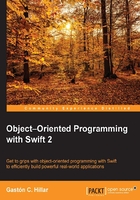
上QQ阅读APP看书,第一时间看更新
Exercises
Now that you understand an instance's life cycle, it is time to spend some time in the Playground creating new classes and instances:
- Exercise 1: Create a new
Employeeclass with a custom initializer that requires two string arguments:firstNameandlastName. Use the arguments to initialize properties with the same names as the arguments. Display a message with the values forfirstNameandlastNamewhen an instance of the class is created. Display a message with the values forfirstNameandlastNamewhen an instance of the class is destroyed.Create an instance of the
Employeeclass and assign it to a variable. Check the messages printed in the Playground's Debug area. Assign a new instance of theEmployeeclass to the previously defined variable. Check the messages printed in the Playground's Debug area. - Exercise 2: Create a function that receives two
stringarguments:firstNameandlastName. Create an instance of the previously definedEmployeeclass with the received arguments as parameters for the creation of the instance. Use the instance properties to print a message with the first name followed by a space and the last name. You will be able to create a method and add it to theEmployeeclass later to perform the same task. However, first, you must understand how you can work with the properties defined in a class.